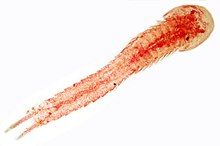
Dendrobranchiata is a suborder of decapods, commonly known as prawns. There are 540 extant species in seven families, and a fossil record extending back to the Devonian. They differ from related animals, such as Caridea and Stenopodidea, by the branching form of the gills and by the fact that they do not brood their eggs, but release them directly into the water. They may reach a length of over 330 millimetres (13 in) and a mass of 450 grams (1.0 lb), and are widely fished and farmed for human consumption.

Copepods are a group of small crustaceans found in nearly every freshwater and saltwater habitat. Some species are planktonic, some are benthic, a number of species have parasitic phases, and some continental species may live in limnoterrestrial habitats and other wet terrestrial places, such as swamps, under leaf fall in wet forests, bogs, springs, ephemeral ponds, and puddles, damp moss, or water-filled recesses (phytotelmata) of plants such as bromeliads and pitcher plants. Many live underground in marine and freshwater caves, sinkholes, or stream beds. Copepods are sometimes used as biodiversity indicators.

Mystacocarida is a subclass of crustaceans, that form part of the meiobenthos. They are less than 1 mm (0.04 in) long, and live interstitially in the intertidal zones of sandy beaches.

Tantulocarida is a highly specialised group of parasitic crustaceans that consists of about 33 species, treated as a subclass of the class Hexanauplia. They are typically ectoparasites that infest copepods, isopods, tanaids, amphipods and ostracods.
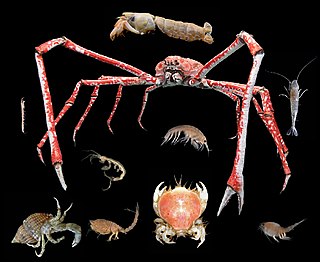
Malacostraca is the largest of the six classes of crustaceans, containing about 40,000 living species, divided among 16 orders. Its members, the malacostracans, display a great diversity of body forms and include crabs, lobsters, crayfish, shrimp, krill, woodlice, amphipods, mantis shrimp and many other, less familiar animals. They are abundant in all marine environments and have colonised freshwater and terrestrial habitats. They are segmented animals, united by a common body plan comprising 20 body segments, and divided into a head, thorax, and abdomen.

Mysida is an order of small, shrimp-like crustaceans in the malacostracan superorder Peracarida. Their common name opossum shrimps stems from the presence of a brood pouch or "marsupium" in females. The fact that the larvae are reared in this pouch and are not free-swimming characterises the order. The mysid's head bears a pair of stalked eyes and two pairs of antennae. The thorax consists of eight segments each bearing branching limbs, the whole concealed beneath a protective carapace and the abdomen has six segments and usually further small limbs.

Isopoda is an order of crustaceans that includes woodlice and their relatives. Isopods live in the sea, in fresh water, or on land. All have rigid, segmented exoskeletons, two pairs of antennae, seven pairs of jointed limbs on the thorax, and five pairs of branching appendages on the abdomen that are used in respiration. Females brood their young in a pouch under their thorax.

Harpacticoida is an order of copepods, in the subphylum Crustacea. This order comprises 463 genera and about 3,000 species; its members are benthic copepods found throughout the world in the marine environment and in fresh water. A few of them are planktonic or live in association with other organisms. Harpacticoida represents the second-largest meiofaunal group in marine sediments, after nematodes. In Arctic and Antarctic seas, Harpacticoida are common inhabitants of sea ice. The name Harpacticoida comes from the Greek noun harpacticon and the suffix -oid and means reminiscent of a predator.

The Cephalocarida are a class in the subphylum Crustacea comprising only 12 benthic species. They were discovered in 1955 by Howard L. Sanders, and are commonly referred to as horseshoe shrimps. They have been grouped together with the Remipedia in the Xenocarida. Although a second family, Lightiellidae, is sometimes used, all cephalocaridans are generally considered to belong in just one family: Hutchinsoniellidae. Though no fossil record of cephalocaridans has been found, most specialists believe them to be primitive among crustaceans.
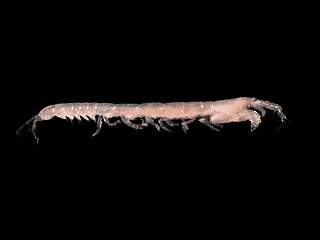
The crustacean order Tanaidacea make up a minor group within the class Malacostraca. There are about 940 species in this order.

Eucarida is a superorder of the Malacostraca, a class of the crustacean subphylum, comprising the decapods, krill, Amphionides and Angustidontida. They are characterised by having the carapace fused to all thoracic segments, and by the possession of stalked eyes.
The Glossosomatidae are a family of the class Insecta and order Trichoptera.The family contains 23 genera in three subfamilies. In the US alone, there are 76 spp. in 6 different genera.

The external morphology of Lepidoptera is the physiological structure of the bodies of insects belonging to the order Lepidoptera, also known as butterflies and moths. Lepidoptera are distinguished from other orders by the presence of scales on the external parts of the body and appendages, especially the wings. Butterflies and moths vary in size from microlepidoptera only a few millimetres long, to a wingspan of many inches such as the Atlas moth. Comprising over 160,000 described species, the Lepidoptera possess variations of the basic body structure which has evolved to gain advantages in adaptation and distribution.

Insect morphology is the study and description of the physical form of insects. The terminology used to describe insects is similar to that used for other arthropods due to their shared evolutionary history. Three physical features separate insects from other arthropods: they have a body divided into three regions, have three pairs of legs, and mouthparts located outside of the head capsule. It is this position of the mouthparts which divides them from their closest relatives, the non-insect hexapods, which includes Protura, Diplura, and Collembola.

Crustaceans may pass through a number of larval and immature stages between hatching from their eggs and reaching their adult form. Each of the stages is separated by a moult, in which the hard exoskeleton is shed to allow the animal to grow. The larvae of crustaceans often bear little resemblance to the adult, and there are still cases where it is not known what larvae will grow into what adults. This is especially true of crustaceans which live as benthic adults, more-so than where the larvae are planktonic, and thereby easily caught.
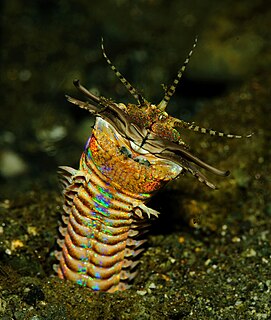
Eunicida is an order of polychaete worms.
Nicothoë astaci or the 'lobster louse' is an ectoparasitic copepod that parasitises the gills of the European lobster species Homarus gammarus. The lobster louse was first reported in 1826 by Audoin & Milne-Edwards. N. astaci has been found on lobsters inhabiting locations including Scotland, Lundy Island in the Bristol Channel and as far south as France and Portugal. The louse possesses a narrow suctorial mouthpart to feed on host haemolymph. Internally, In its adult form, Nicothoe is barely mobile and most likely remains in the same position for most of its life. The parasite occurs in groups, particularly near the base of the gills, and study has gone into its effects on the lobsters, which are considerably important, commercially. Not much is known about its life cycle, since there are significant gaps in knowledge of certain stages of its growth.

Crustaceans form a large, diverse arthropod taxon which includes such animals as crabs, lobsters, crayfish, shrimps, prawns, krill, woodlice, and barnacles. The crustacean group can be treated as a subphylum under the clade Mandibulata; because of recent molecular studies it is now well accepted that the crustacean group is paraphyletic, and comprises all animals in the clade Pancrustacea other than hexapods. Some crustaceans are more closely related to insects and the other hexapods than they are to certain other crustaceans.
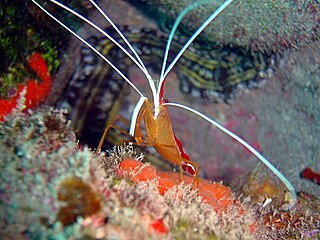
Lysmata grabhami is a species of saltwater shrimp in the family Hippolytidae. It was first described by Gordon in 1935. It occurs in the tropical and subtropical Atlantic Ocean and is a cleaner shrimp, operating a cleaning station to which fish come to have parasites removed.
Propallene longiceps is a species of sea spider in the family Callipallenidae. It is found in shallow water in the western Pacific Ocean.
